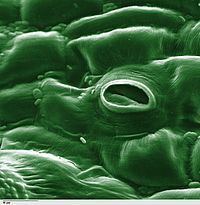
Photo from wikipedia
Drought is one of the abiotic stresses which impairs the plant growth/development and restricts the yield of many crops throughout the world. Stomatal closure is a common adaptation response of… Click to show full abstract
Drought is one of the abiotic stresses which impairs the plant growth/development and restricts the yield of many crops throughout the world. Stomatal closure is a common adaptation response of plants to the onset of drought condition. Stomata are microscopic pores on the leaf epidermis, which regulate the transpiration/CO2 uptake by leaves. Stomatal guard cells can sense various abiotic and biotic stress stimuli from the internal and external environment and respond quickly to initiate closure under unfavorable conditions. Stomata also limit the entry of pathogens into leaves, restricting their invasion. Drought is accompanied by the production and/or mobilization of the phytohormone, abscisic acid (ABA), which is well-known for its ability to induce stomatal closure. Apart from the ABA, various other factors that accumulate during drought and affect the stomatal function are plant hormones (auxins, MJ, ethylene, brassinosteroids, and cytokinins), microbial elicitors (salicylic acid, harpin, Flg 22, and chitosan), and polyamines . The role of various signaling components/secondary messengers during stomatal opening or closure has been a matter of intense investigation. Reactive oxygen species (ROS) , nitric oxide (NO) , cytosolic pH, and calcium are some of the well-documented signaling components during stomatal closure. The interrelationship and interactions of these signaling components such as ROS, NO, cytosolic pH, and free Ca2+ are quite complex and need further detailed examination.Low temperatures can have deleterious effects on plants. However, plants evolved protection mechanisms to overcome the impact of this stress. Cold temperature inhibits stomatal opening and causes stomatal closure. Cold-acclimated plants often exhibit marked changes in their lipid composition, particularly of the membranes. Cold stress often leads to the accumulation of ABA, besides osmolytes such as glycine betaine and proline. The role of signaling components such as ROS, NO, and Ca2+ during cold acclimation is yet to be established, though the effects of cold stress on plant growth and development are studied extensively. The information on the mitigation processes is quite limited. We have attempted to describe consequences of drought and cold stress in plants, emphasizing stomatal closure. Several of these factors trigger signaling components in roots, shoots, and atmosphere, all leading to stomatal closure. A scheme is presented to show the possible signaling events and their convergence and divergence of action during stomatal closure. The possible directions for future research are discussed.
Journal Title: Advances in experimental medicine and biology
Year Published: 2018
Link to full text (if available)
Share on Social Media: Sign Up to like & get
recommendations!